Face-to-face events like public meetings and consultations are, with good reason, at the heart of much public engagement. They provide a dedicated block of time and a common space to learn about, discuss, and gather community input into public issues. However, no matter how well designed the event, such gatherings are pointless if nobody shows up, or only one segment of a community participates.
That’s where creative street and online engagement comes in. These approaches can reach people who normally never attend public meetings. They can be used to gather input from the public in fun ways in places they normally frequent and/or entice them to later travel to a face-to-face event to discuss an issue in greater depth.
This week I experimented with various approaches to creative street and online engagement by using the “edges” of a three day face-to-face event: “Leading Engagement: Involving People in the Decisions that Affect Them”. This was the first Art of Hosting experiential training specifically focused on the topic of engagement. It was held in the education center of the Morton Arboretum outside of Chicago and drew a diverse group of around 70 people from the non-profit, corporate, and government sectors.
One set of “edges” I used were physical spaces outside of the main meeting rooms, like hallways and bathrooms. These served as the event’s equivalent of streets and other public spaces. Another set of “edges” were tech tools and social media: online public spaces where people not physically present at the event could also contribute to and/or learn from the event.
Four principles guided my design:
1. Go where people already are and use tech tools they already have. This meant first learning which social media participants use and focusing on those. It also meant using physical spaces all participants would pass through, like the hallway next to the lunch room.
2. Make activities short, simple, and self-explanatory. Activities needed to connect to the event theme but not distract from the core event proceedings.
3. Consider different learning styles and modes of participation. In some activities, people physically moved something. In others, they played with words or took pictures.
4. Use only existing resources and prepare quickly. I had no budget and very little time. My only resources were an ipad and basic office supplies. I had less than 30 minutes each day to design activities.
Here are the low-tech engagement methods I tried that seemed most effective:
 Bean survey. At the registration desk, participants dropped beans in cups labeled with names of social media they used (i.e., Facebook, Twitter). This was a fun way to choose social media for the event.
Bean survey. At the registration desk, participants dropped beans in cups labeled with names of social media they used (i.e., Facebook, Twitter). This was a fun way to choose social media for the event.
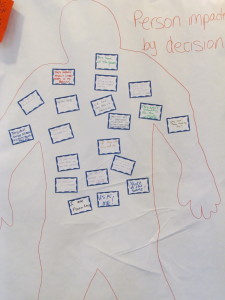 Thought stickers. Posters with life-size outlines of two people: a “decision maker” and a “person affected by that decision” were hung in the entryway. Participants placed “hello” badges on each figure with what each was thinking, but not saying. Responses were thought-provoking and sometimes funny.
Thought stickers. Posters with life-size outlines of two people: a “decision maker” and a “person affected by that decision” were hung in the entryway. Participants placed “hello” badges on each figure with what each was thinking, but not saying. Responses were thought-provoking and sometimes funny.
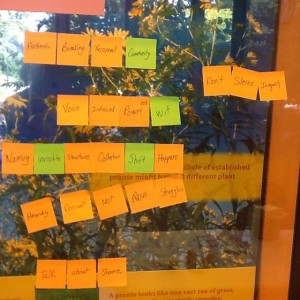 Post-it Poetry. Individual words, taken from a flip chart summary of themes from a world café, were written on post-it notes. These were then placed on a big glass case in the entryway where people used them to create simple poems. This offered a fun, social, and creative way to further reflect on key themes emerging from discussions.
Post-it Poetry. Individual words, taken from a flip chart summary of themes from a world café, were written on post-it notes. These were then placed on a big glass case in the entryway where people used them to create simple poems. This offered a fun, social, and creative way to further reflect on key themes emerging from discussions.
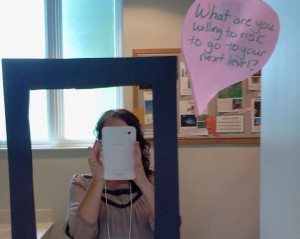 Reflection Frame. A construction paper frame was taped on bathroom mirrors with the question “what are you willing to risk to go to your next level?” This invited a moment of personal reflection in an unexpected place.
Reflection Frame. A construction paper frame was taped on bathroom mirrors with the question “what are you willing to risk to go to your next level?” This invited a moment of personal reflection in an unexpected place.
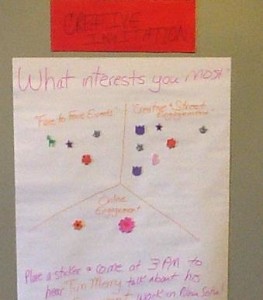 Creative Invitation. To promote an afternoon talk, participants were invited to place fun stickers on a poster to show their interest in three topics to be addressed in that talk. This both helped the speaker prepare and got participants excited about the talk.
Creative Invitation. To promote an afternoon talk, participants were invited to place fun stickers on a poster to show their interest in three topics to be addressed in that talk. This both helped the speaker prepare and got participants excited about the talk.
In addition to low-tech interventions, I also experimented with several simple technology tools and social media. It is important to note that I had never used any of these, other than Twitter and i-recorder, prior to this event. Their use was either self-explanatory or easy to quickly figure out (e.g., with “how to” videos on You Tube). Click on the links in bold to learn more.
SMS Harvest. This simple web-based application provided a quick way to harvest learning from a world café with 70 people. Using their cell phones, participants each sent a text message (SMS) with their personal takeaways from the discussions. Responses were then automatically turned into a word cloud which was projected onto a screen in the main meeting room.
Twitter. To connect the live event with Art of Hosting practitioners globally, participants were asked to tweet using a hashtag designed for this purpose: #aohlive. Occasionally a live Twitter feed was projected onto the meeting room screen. In addition, a special event Twitter account (@aohengage) was created to share ideas, photos, and links to videos from the event.
Instagram. Participants were invited to upload event photos to Instagram using a special event hashtag #aohengage. The web-based application Eventstagr.am was then used to display an Instragram stream on the meeting room screen, accompanied by an audio montage (see below).
Ustream. Major talks and teaching sessions were live-streamed and recorded to a Ustream channel created for the event: “Leading Engagement”. These live-streams were promoted in advance using Twitter. Viewers were invited to share feedback via the chat function. Within two days, over 50 people had already watched the recorded videos.
Audio montage. Participant feedback on the first day was collected using a “roving reporter” who recorded participants’ short answers to the question “what was your biggest takeaway today?” via i-recorder. These audio files were then compiled into a short audio montage using the garage band app.
Not only did these creative street and online engagement approaches provide fun ways to engage both participants and interested outsiders during the event, they also left behind a trail of pictures, videos, and written reflections that can be used to synthesize learning and compile the final event report.
With limited resources and time, I could barely scratch the surface of the tremendous potential of these approaches. However, I definitely plan to continue to experiment with them for future public engagement projects, drawing inspiration from sources such as Art of Hosting harvesting tools, Placemaking, and participatory urban design (e.g., Spontaneous Interventions).
“Use the edges and value the margins” is a core principle of permaculture, a design philosophy originating in gardening and environmental planning. One reason to do this is because the most interesting things often happen off the beaten path. Likewise, the “edges” of events (e.g., concerts, street fairs) and public spaces (e.g., streets, parks, libraries), as well as social media, provide many promising opportunities to engage people who don’t normally attend public meetings. Not only could this help them to impact decisions that affect them, but they just might contribute the missing insights and unique ideas that will help to better address complex challenges like climate change and youth violence.
Word cloud is from SMS Harvest.
Photos: Janice Thomson and Dana Keim (from Instagram), Andrea Johnson (Thought Stickers)
Audio montage compiled by Kevin A. Johnson
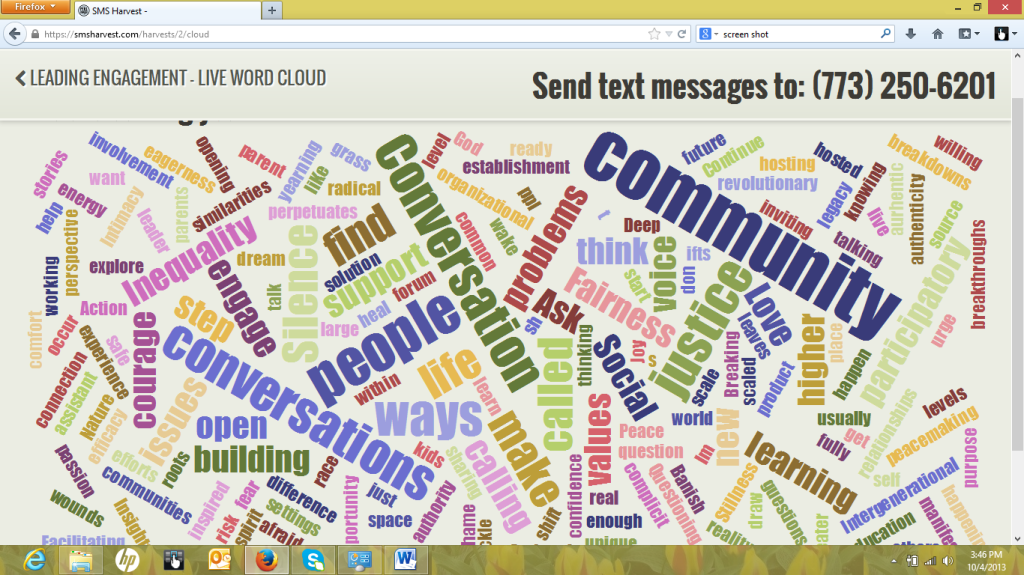
Thank you for the opportunity to hear Tim Merry Thursday morning. That was an exciting meeting. I hated leaving at 10:00, but I had to run to a previous engagement.
Thank you for the tips above.
Nancy
Very nice!
Is the audio montage available anywhere?
Thanks Tim for sharing! I uploaded the audio montage to Sound Cloud. I put a link to it in the post. Here it is again: https://soundcloud.com/user316483571/leading-engagement-aoh-day-one
BTW. I did also consider using Zilino for parallel online discussions, but didn’t have enough advance preparation time. I didn’t even know that this would be my role in the training until the evening before the training began!
Inspiring!!! Amazing what can be done with so little–you showed us howl.
Pingback: Edgy Engagement from Chicago
You did an AMAZING job. I learned a lot and had lots of fun.
Great straight forward summary. I would like To share this with art of hosting Medellín ( Colombia) But i cant find a link.
Thanks
Heather
Thanks Heather. I’m not sure why the article link isn’t appearing. Try sharing this: http://www.janicethomson.net/engaging-on-the-edges-planning-creative-street-and-online-engagement/